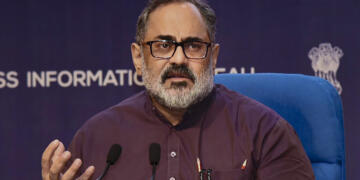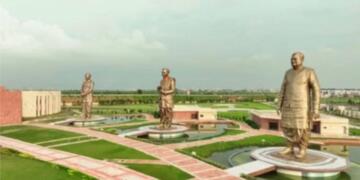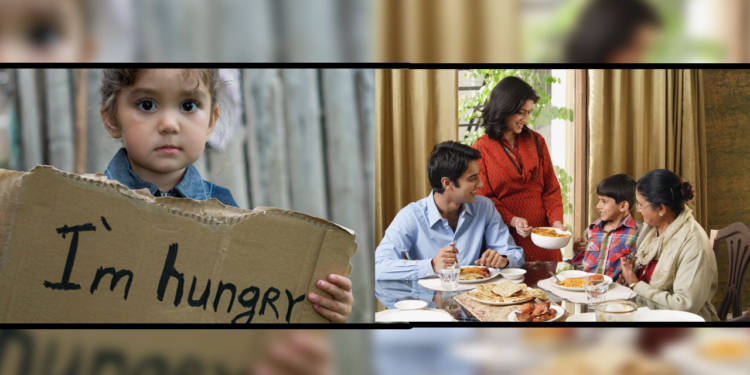The COVID-19 pandemic has brought about humongous changes around the world, and first world countries are on their knees. It is generally seen that a tectonic shift in either the global economy, by means of recession or what is today prevalent – a pandemic, or even a war for that matter, hits the first world countries harsher than how it affects modern nation states like India, for example.
The United States of America is going through a very tough time. With the number of infected individuals soaring to 1.30 million, and the death toll mounting to 77,000, the often proudly paraded American “way of life” has been dealt a severe blow.
Now while Americans are finding it difficult to cope with all aspects of dealing with the pandemic, back here in India, things are going on rather smoothly. For instance, we look at the levels of food insecurity which are being reported from the United States, the observations of which are mind-chilling.
By the end of April, more than one in five households in the United States, and two in five households with mothers with children 12 and under, were food insecure. In almost one in five households of mothers with children aged 12 and under, the children were experiencing food insecurity, according to The COVID Impact Survey and The Hamilton Project/Future of the Middle Class Initiative Survey of Mothers with Young Children.
Food insecurity occurs when a household has difficulty providing enough food to members due to lack of resources. COVID-19 has made American households increasingly food-insecure, with many being forced to resort to diet rationing. Children are skipping meals, and 1 out of every 5 children is possibly faced with hunger. The corresponding data collected in previous years suggests that food insecurity has risen magnanimously due to COVID-19.
Meanwhile, the number of unemployment filings in the United States has crossed the 26 million figure since March 14, and only in the week ending April 18, another 4.4 million people filed for unemployment. This translates effectively to a whooping 26 million Americans feeling, or even experiencing unemployment due to the raging pandemic.
Why has a supposed ‘first world’ and the most powerful country in the world, been forced to reduce its food consumption at the household level? The US economy is seen usually oscillating vigorously with any major global change around the world, and with COVID-19, they have a tiny virus hitting them at their very foundations.
India, on the other hand, is faring far well on similar grounds, and Indians are not having to go hungry. Of course, many might argue that the lowest strata of people, below the poverty line, are still not having enough to feed themselves, however, that really is a phenomenon seen even before COVID-19 took birth in a Chinese lab. The fact is that Indians are not insecure about whether they will be able to afford meals for themselves in the near future or not.
Further, India being an agricultural economy which consumes food products grown domestically, does not face an imminent shortage of food supplies, and rest assured, Indians will not have to go hungry in the future.
As reported earlier by TFIPOST, India has food surplus to support its entire population for the next few years even if the crop production is zero. Food Corporation of India, the central government agency tasked to ensure food security, alone has 646 lakh tonnes of food while the total food requirement to maintain supply till April 1 was 210 lakh tonnes. That means FCI alone could supply the food requirement of the entire country for the next few years. Moreover, the state government agencies also have huge buffer stock of grains.
What is also unique about India is our strong sense of belonging towards families. Being a family-oriented nation, unlike the West, Indians in crisis can always turn to their families and relatives, who, rest assured, will not let anyone go hungry. A closely knit family will ensure that all its members are well fed, no matter what the circumstances. Further, the concept of savings which close to every Indian follows is what is proving to be a boon for many in these unprecedented times.
Food security in India is a primary reason why many are willing to adhere to lockdown guidelines, optimizing their stay indoors to inculcate and learn new aspects of life previously unknown to them. Who would have thought that the USA would face a food crisis, even as Indians enjoy and post food pictures on Instagram.
Such is 2020, where first world countries are capable of braving all disasters only on the silver screen, while countries like India lead the way in reality.
Societies in the West, particularly the United States, do not have a family oriented mindset, and almost every individual yearns to leave their households after they turn 18 to pursue higher studies, while incurring massive amounts of expenditure and debt from a young age. This puts them in no position to save any money whatsoever for crises such as these.
American society has drastically changed from the 1960’s, and having a two parent household is really a boon for children. Divorce, remarriage, single-parenthood are factors which hinder the American society from being a ‘family-oriented’ one. The fluidity of American society is a major factor as to why Americans cannot turn to their families in such unprecedented times, and would rather suffer than be perceived as a burden by their families. This is further proven by the fact that hunger relief organizations have seen an earth-shattering spike in demand of Americans looking for free food.
‘Feeding America’, the country’s largest hunger relief organization, highlighted a 98 percent increase in demand for free food and, expects to lose $1.4 billion trying to survive. The same can be seen for other relief organizations, who are experiencing doubling, and even tripling of demand. Americans are increasingly looking at availing free food from food banks across the country, as resources to keep themselves fed dry out amidst a shutdown.
Food banks across the United States are witnessing scores of cars lining up with people in desperate need of food. While these people have cars, they are somehow not able to avail food for themselves, further validating our proposition that America has proven to be a fragile economy.
In contrast, will any Indian who owns a car, go hungry at the drop of a hat? The answer would be a big no. The fundamental difference between Indian and American societies is what is helping the former brave the crisis almost seamlessly, while the latter struggles to survive.
The COVID-19 crisis can be a wakeup call for America, to turn back to the traditional family structure, and begin being more humane for one another. The lack of a support system, in the form of families is what has cost Americans dearly. They might have to consider shunning their egos and begin learning the art of co-existence.

































